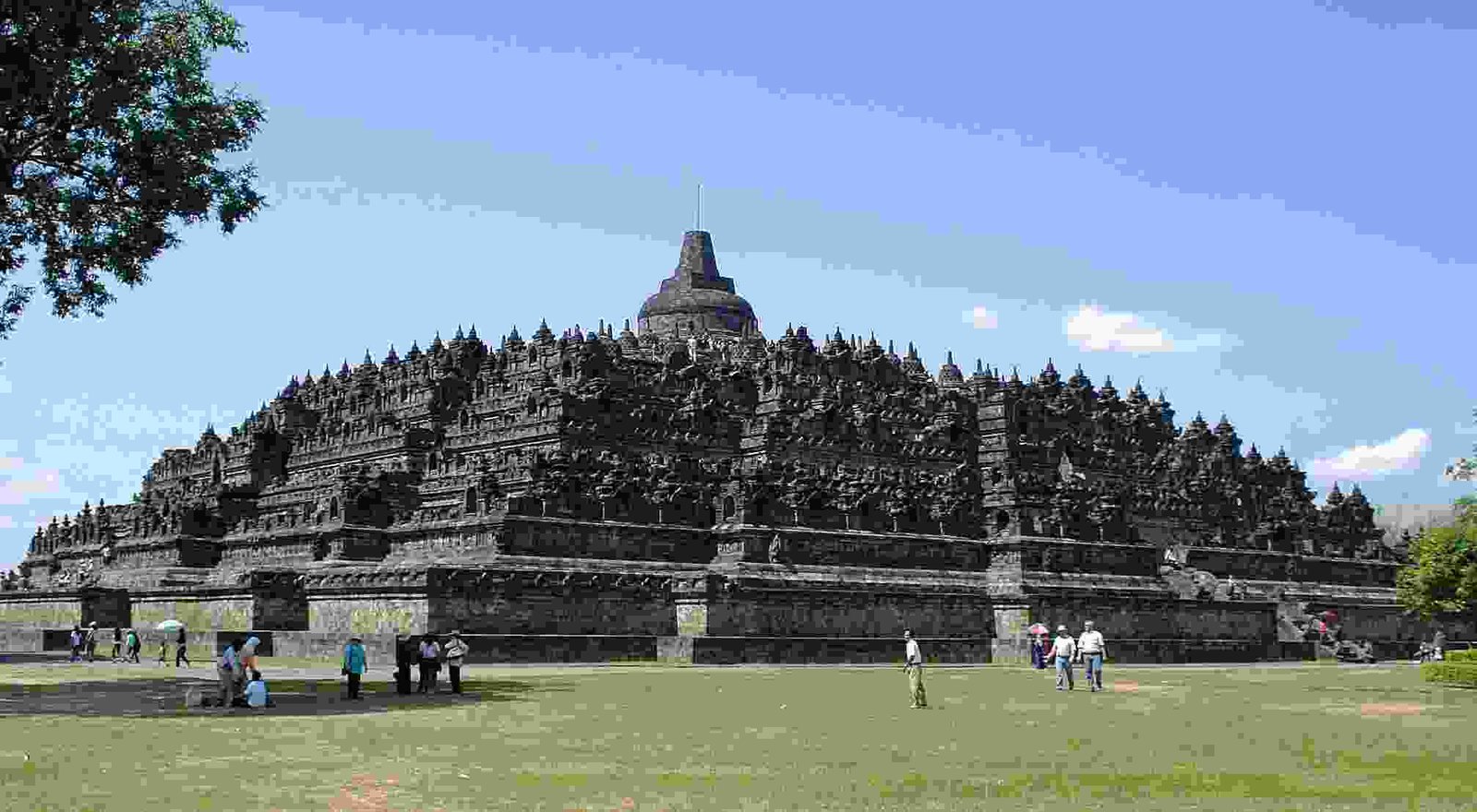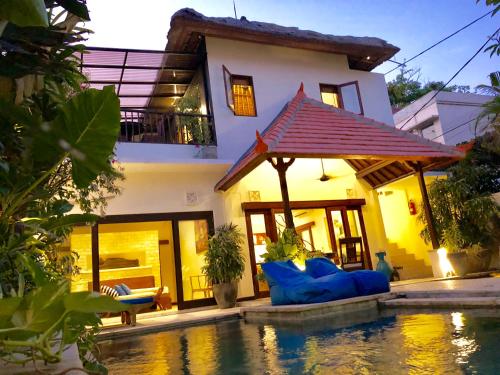From Bali to Yogyakarta, the Beating Heart of Javanese Culture
Yogyakarta (or Jogja) is a must visit destination for travelers to Java Island. Renowned for being the cultural center of Java, this student city attracts many artists and intellectuals from all the provinces of the Indonesian archipelago. Direct flight from Bali to Yogyakarta it takes 1 hour and 30 minutes.
Yogyakarta is also a city apart in Indonesia, because it is still under the governance of a sultan and has inherited a cultural richness that is now visible through the many palaces, museums, temples and historic buildings. In this article I share with you all the information to visit the city of Yogyakarta!
The famous temples of Borobudur and Prambanan, both listed as World Heritage by Unesco, are located near Yogyakarta.
3 Ways to get from Bali to Yogyakarta
Plane
Flying is by far the fastest and easiest way to reach Bali from Yogyakarta to Bali. The flight takes less than 2 hours with tickets starting at IDR 650,000 (US$ 40). Note that this includes short taxi transfers to and from the airports.
What airline companies run direct flight services from Bali and Yogyakarta?
Train and ferry
If you feel like an adventure and have time for it, you can also take a combined train and ferry trip from Bali to Yogyakarta. The trip takes at least 19 hours, through East Java and along the west coast of Bali, including an additional bus ride from the port to central or south Bali. The total cost is approximately IDR 500,000 (US$ 32). If you decide to go overland, we highly recommend visiting the Bromo and Ijen volcanoes as well as the Sewu waterfalls.
Bus
It’s also possible to take the bus from Bali to Yogyakarta, but it’s an uncomfortable 20-hour trip that involves several transfers and is often affected by delays. Long-distance buses can be very tiring and are not the safest way to travel, especially at night.
Experience and visit the constant hustle and bustle of Yogyakarta city and visit the Sultan’s Palace, Water Palace and UNESCO sites such as the ancient Borobudur Temple or Prambanan during your visit to Yogyakarta.

Stupas on top terrace at Borobudur. Sasha India, CC BY 2.0, via Wikimedia Commons
Visit Yogyakarta (the City)
1. Sultan’s Palace (Kraton)
The sultan still resides in Yogyakarta. He is the governor of Central Java and has a large palace in the city center, which is open for visits every morning. The Sultan’s Palace is a beautiful place, but don’t expect anything lavish, the whole thing remains rather simple. Inside, objects and photos on display, generally without much explanation. It’s worth going there but we don’t come out impressed either.
Every day a different show is held at the Sultan’s Palace depending on the day of the week. We were there on a Saturday, the day of the wayang kulit, the puppets, which are an integral part of the traditional culture. A bit boring when you don’t understand Indonesian but the backstage area, with the orchestra dressed in traditional attire, is worth seeing.
The Sultan’s Palace and the surrounding streets form an entire district called Kraton. Far from the hustle and bustle of the rest of the city of Yogya, the streets of Kraton are very quiet and green. There are merchants and craftsmen there, it’s pleasant.
The spiritual and royal center of Yogyakarta, the Kraton is the sultan’s palace, where the royal family resided for centuries
It is rather large, it takes a good hour to go around. It is like a mini-city, there are courtyards with elegant pavilions. I advise you to take a guide who can explain the interior of the Kraton and contextualize the history of the sultanate because a visit alone is not really of interest except to admire the architecture. You can also see dance, music and puppet shows there, there are several throughout the day.
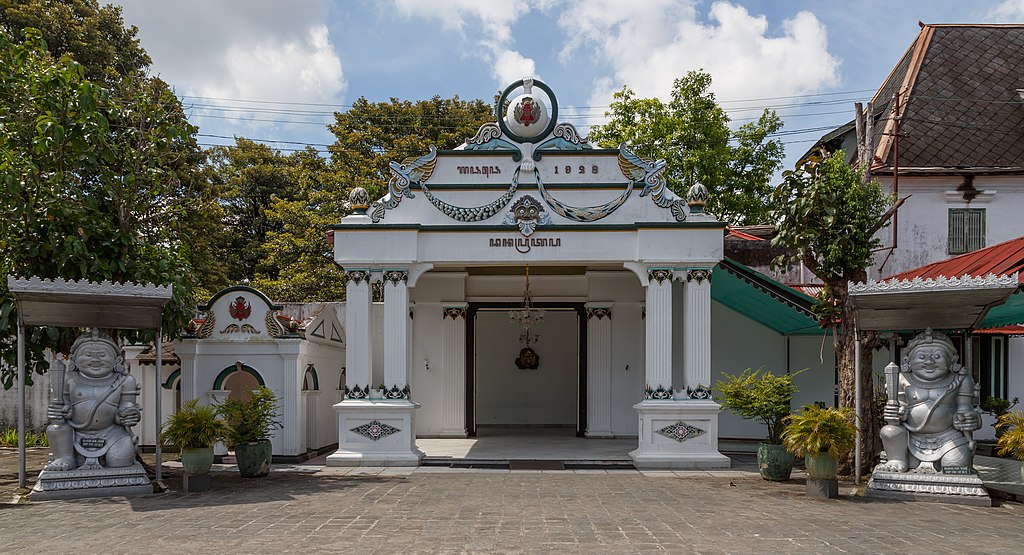
Kraton the Sultan’s (king’s) palace. Photo by CEphoto, Uwe Aranas, CC BY-SA 3.0 via Wikimedia Commons
Address: Jalan Rotowijayan Blok No. 1, Panembahan, Kraton, Kota Yogyakarta
Opening hours: every day from 8:30 a.m. to 2 p.m., Friday from 8:30 a.m. to 1 p.m.
Admission: 20,000 IDR/person (IDR +1,000 for the right to take photos)

Kraton of Yogyakarta. Christophe95, CC BY-SA 4.0, via Wikimedia Commons
2. Visit the Taman Sari (Water Castle) and its underground mosque
Formerly, the Water castle of Yogyakarta was the place where the Sultan and his Court came to bathe. The place could be superb but lacks maintenance. There was almost no water, too bad for a water castle. So it’s a bit sad.
There are a few shops within the grounds. We took the opportunity to watch the work of making traditional wayang kulit puppets, in chiseled leather, as well as batik. Patience work!
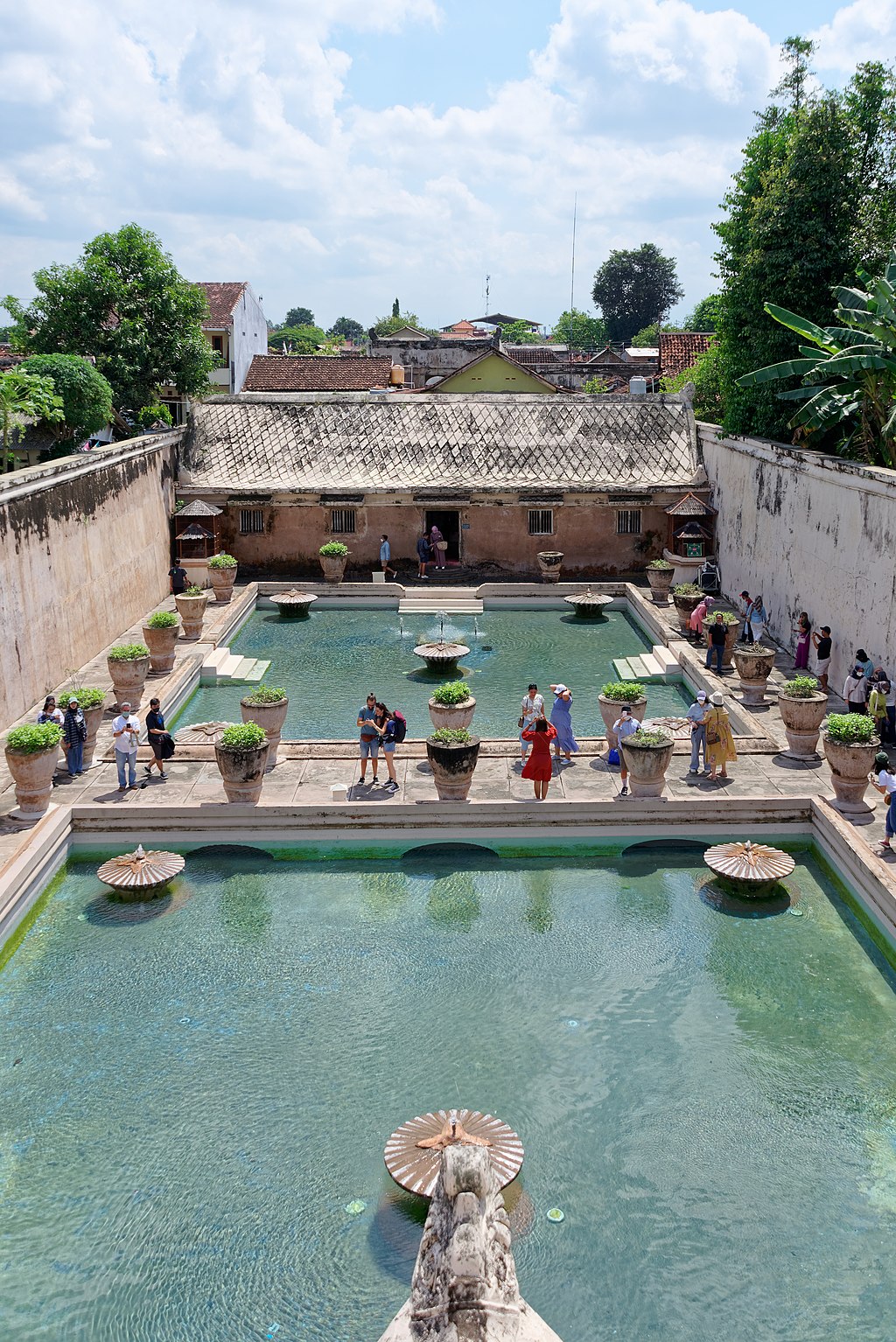
Taman Sari (Water Castle), Yogyakarta, Indonesia. Jakub Hałun, CC BY-SA 4.0, via Wikimedia Commons
Location of Taman Sari (Water Castle)
Located south-west of Kraton, the Taman Sari – literally the “garden of perfumes” – is a palace on the water which once served as a place of relaxation and meditation built at the request of the sultan in the 18th century. At the time, this large royal park housed luxurious pools, water games, pavilions and several small lakes as well as rooms to accommodate the sultan’s wives. Today only the baths and bedrooms have been preserved, but the architecture of the castle is no less impressive. There are also many underground tunnels and an underground mosque. The place is a real labyrinth when you do not know the places. I advise you to take a guide who can explain the places to you and immerse you in the history of this magnificent aquatic palace.
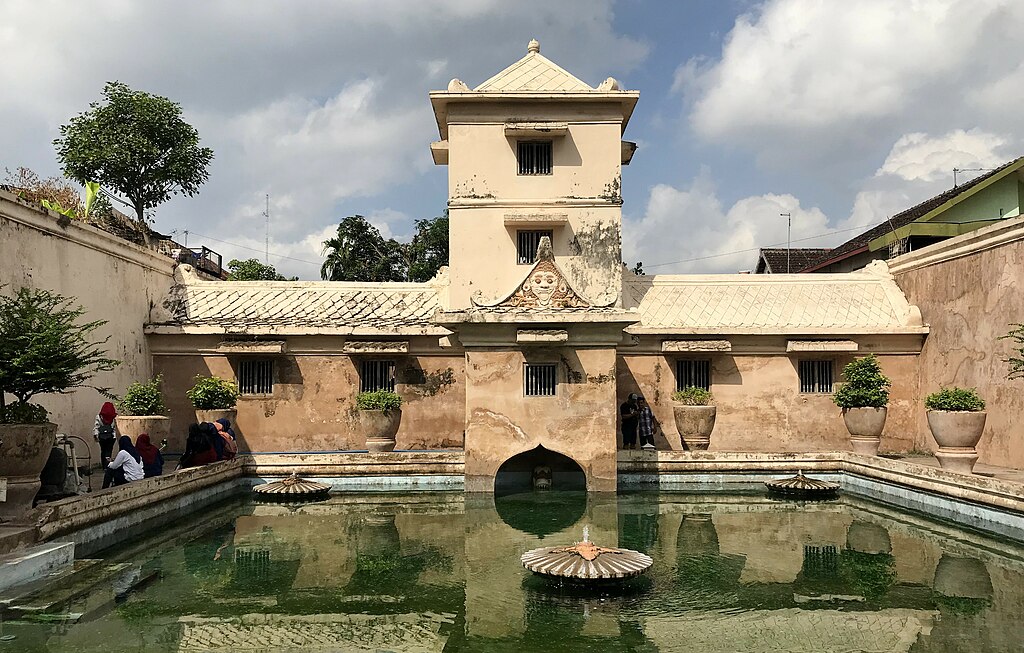
Taman Sari Water Castle, Yogyakarta. Dudva, CC BY-SA 4.0, via Wikimedia Commons
Address: Wisata Taman Sari, Taman, Patehan, Kraton, Kota Yogyakarta
Hours: daily from 9 a.m. to 3 p.m.
Admission: IDR 15,000/person
3. Stroll through the Prawirotaman district and admire the street-art
The Prawirotaman district is one of the most frequented districts in Yogyakarta by tourists. Indeed, this district brings together all the hotels, restaurants, bars and travel agencies of the city. It is particularly in this district that we recognize that Yogyakarta is a city populated by artists, because the walls of this district have been magnificently decorated by young local artists, lovers of street-art!
4. Visit a batik workshop
Batik is a fabric dyeing technique widely used in Indonesia. This traditional technique comes from Yogyakarta and was exported throughout the Indonesian archipelago, then to Africa. In Yogyakarta, you can therefore visit one of the many batik workshops, meet local artists and admire them handling the technique meticulously, or even try it yourself.

This lady is weaving batik, the national cloth of Indonesia. Michael Gunther, CC BY-SA 4.0, via Wikimedia Commons
5. Walk down Malioboro Street and City Centre
Malioboro Street will immerse you directly in local life. It is an essential walk to do if you come to Yogyakarta: many shops, small restaurants and food stalls, shops and local market… Ideally to be done in the evening to enjoy the local atmosphere, see people chatting on the benches , enjoy small street concerts. Agoraphobes refrain because it is a really crowded and very lively avenue.
Malioboro Street, Yogyakarta. Gunawan Kartapranata, CC BY-SA 3.0, via Wikimedia Commons
6. Fort Vredeburg Museum
The museum is very strategically located from the city center and has a fairly high value. Maybe for some people who hear the word “museum” or “fort” will think that it is very old-fashioned and boring. However, the Fort Vredeburg Museum is different.
Museum Benteng Vredeburg. Pras, CC BY-SA 3.0, via Wikimedia Commons
The place is quite spacious and there are many spots to take pictures. In a number of buildings within the fort there are dioramas (miniature three-dimensional objects / theater decorations) about Indonesian history. The Vredeburg Fort Museum is one of the tourist attractions in Yogyakarta that must be visited.
7. Visit the Affandi Museum
Afandi is one of the most famous artists in Indonesia. Located by a river, the museum was once its own home. He himself designed and drew the plans for his house as well as the showrooms for his works of art. All his paintings were painted by hand or directly with his paint tubes.
Inspired and influenced by great European artists like Van Gogh, his works are no less original and impressionist in style. This museum is undoubtedly one of the most interesting to visit in Yogyakarta. Not to be missed for art lovers or budding painters!
Address: Jl. Laksda Adisucipto No.167, Papringan, Caturtunggal, Kec. Depok, Kabupaten Sleman, Daerah Istimewa Yogyakarta
Hours: daily from 8:30 a.m. to 4 p.m.
Admission: IDR 50,000/person
8. Museum of Dewantara Kirti Griya
This museum is is a memorial museum that presents an overview of the life and history of Ki Hadjar Dewantara’s struggles. Ki Hadjar Dewantara was a pioneer in the fight for education for Indonesians.

Dewantara Kirti Griya museum collection – Room 6. Dewantara Kirti Griya Museum, CC BY-SA 3.0, via Wikimedia Commons
8. Bird market
Imagine a huge outdoor pet store. There you are, you are at the Yogyakarta bird market (where not only birds are actually sold, but rabbits, cats, dogs, mice, reptiles, fish…).
9. Beringharjo Market
Beringharjo market is a huge covered market in Yogyakarta where you can find everything: a huge choice of batik (printed clothes and fabrics), spices, fruits and vegetables, wicker baskets, trinkets…It’s open in the morning only (from 8 a.m.), and you meet many locals who come to shop there (from the purchase of peppers to the wedding dress).
The atmosphere is really nice, we walk with pleasure in the aisles. No attempt to sell us anything but just smiles. We even got a little lesson on the different spices at a stand!

The Beringharjo market is located in the Malioboro area, Yogyakarta, Central Java, Indonesia. PL09Puryono, CC0, via Wikimedia Commons
10. Eat a gudeg: the culinary specialty of Yogyakarta
Gudeg is one of the culinary specialties of Yogyakarta. This dish is made from young jackfruit boiled in traditional herbs and coconut milk, and served with rice, egg and chicken. It is the flagship dish of the region, so you can easily find it in small shops or stands in the street.

Gudeg Jogja. Eny Santiati, CC BY-SA 4.0, via Wikimedia Commons
Otherwise, we can recommend this address, it is a small restaurant with a terrace serving a very good gudeg at an affordable price. Many locals go there and some tourists:
Gudeg Sagan
Address: Jl. Prof Dr. Herman Yohanes No. 53, Caturtunggal, Depok, Samirono, Kabupaten Sleman, Daerah Istimewa Yogyakarta 55223
Hours: daily from 9 a.m. to 12 a.m.
Activities and places not to miss around Yogyakarta
1. Visit Borobudur Temple
Located 40km from the city center, the Borobudur temple is a must visit place for tourists who come to visit Java. The largest Buddhist temple in the world, Borobudur is also the most visited tourist site in Indonesia. If you want to admire the sunrise at the top of the temple, you will have to put your hands in your pocket, but it is worth it because the view from the top is incredible, and there will be fewer tourists than during the day.
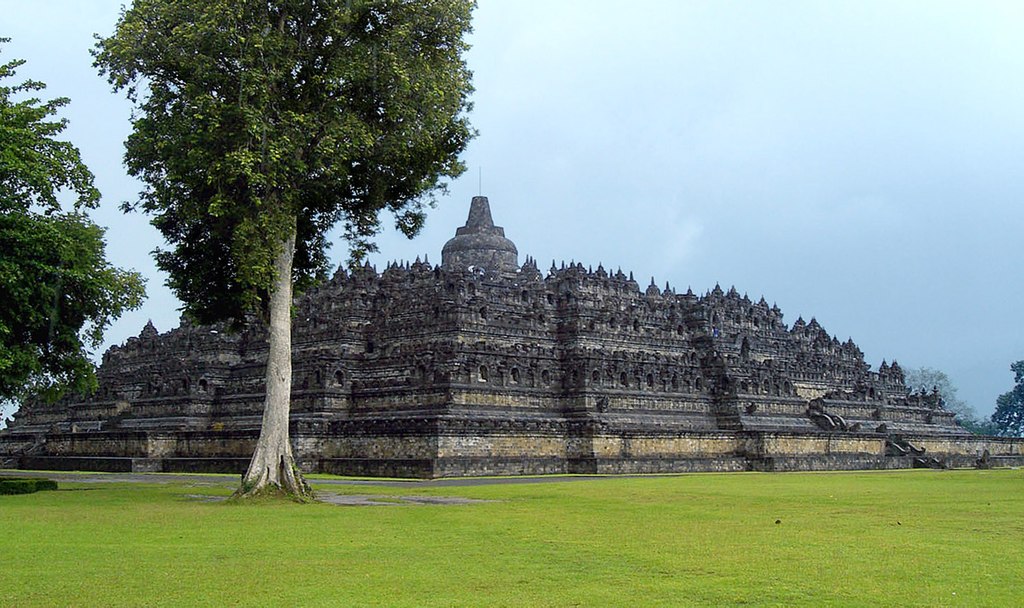 Borobudur temple, Jogja. Gunawan Kartapranata, CC BY-SA 4.0, via Wikimedia Commons
Borobudur temple, Jogja. Gunawan Kartapranata, CC BY-SA 4.0, via Wikimedia Commons
The Manohara hotel (2-star hotel) located inside the park is the only one that offers a special “sunrise tour” ticket to watch the sunrise. For the simple visit of the temple at conventional times, you can benefit from a student rate if you have your student card (to have in hand, or photocopied), i.e. 50% reduction.
Short history:
The main stupa enthroned at Borobudur Temple in Central Java, Indonesia. The world’s largest Buddhist monument was built in the 8th century by the Syailendra dynasty. The upper terrace is round in shape with a row of bell-shaped stupas containing a Buddha figure which symbolizes Arupadhatu, the realm of the formless. The main stupa itself is empty, symbolizing complete perfection of enlightenment.

Borobudur Temple in Jogja – Central Java, Indonesia. Gunkarta, CC BY-SA 3.0, via Wikimedia Commons
Address: Jl. Badrawati, Kw. Candi Borobudur, Borobudur, Magelang, Jawa Tengah
Hours: daily from 6 a.m. to 5 p.m., but possible to buy a more expensive ticket to see the sunrise at 5 a.m.
Admission: 325,000 IDR/person (450,000 IDR for the sunrise tour via the Manohara hotel) and 162,500 IDR for students with their student card.

Borobudur temple with its stupas, a UNESCO World Heritage Site. Borobudur temple view from northwest plateau, Central Java, Indonesia. Photo by CEphoto, Uwe Aranas (CC BY-SA 3.0) via Wikimedia Commons
2. Climb the Merapi Volcano
Culminating at a height of 2934 meters, the Merapi volcano dominates the city of Yogyakarta. It is the most active volcano in Indonesia, its last eruption dates from May 2018. Before climbing the volcano, check with the agency organizing your trek to find out about the activity of the volcano and to know if the roads are in good condition.
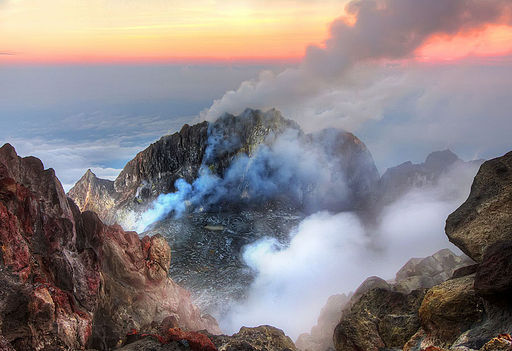
Inside an active volcano – Merapi volcanoe. Jimmy McIntyre – Editor HDR One Magazine, CC BY-SA 2.0, via Wikimedia Commons
You can also do the Merapi Lava Tour: for 2 hours, you can rent a jeep with driver for 350,000 rupees and visit the Merapi volcano and its surroundings. The jeep can carry 3 to 5 people, and the tour includes a visit to Museum Sisa Hartaku, a small museum showing the damage caused by previous eruptions of the Merapi volcano: old motorcycles, clothes, objects and furniture that have more or less resisted the eruption…

Merapi Volcano during sunrise. Desember01, CC BY-SA 4.0, via Wikimedia Commons
To be able to admire the sunrise, you have to get up and leave very early from Yogyakarta. Count about 1h30 for the car trip to the bottom of the volcano, and about 4h for the hike. Once at the top, the sunrise offers a magnificent and unforgettable spectacle. After so much effort for the ascent, the reward is all the more beautiful!
To book, you can go directly through a local agency on site at the entrance to Mount Merapi.
3. Watch the sunset at Prambanan Temple
Classified as a World Heritage Site by UNESCO, the Prambanan Temple is a set of 240 temples that were built in the 9th century. This site includes 4 main temples and several small ruined temples. It is a large site that requires at least 2 good hours of visit if you are on foot (you can also visit the site by bike).
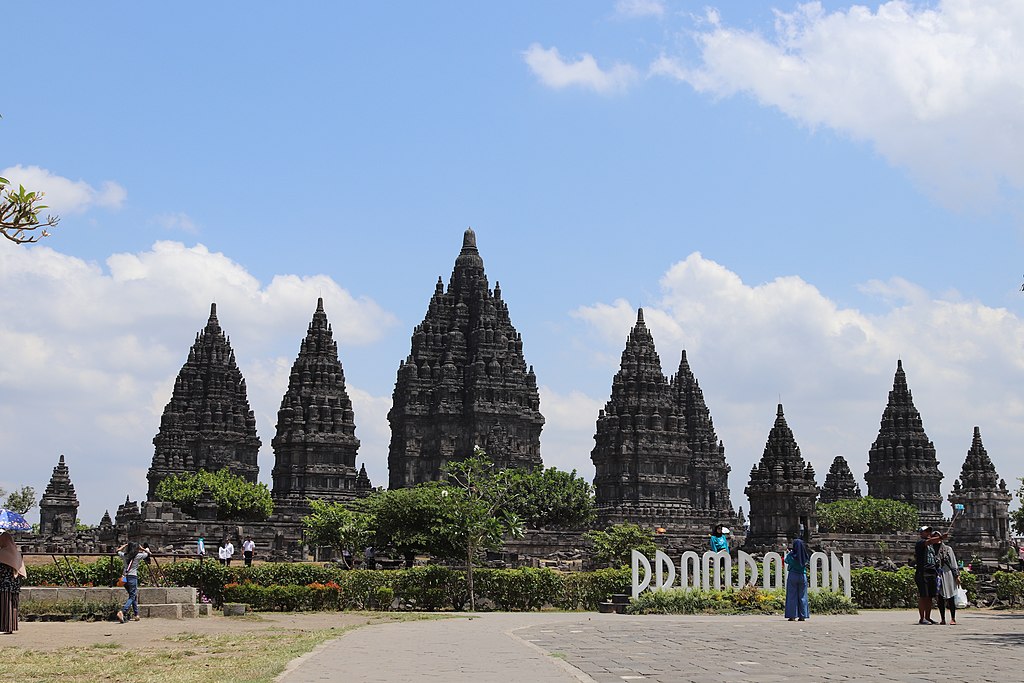 Candi Prambanan. Ridwanpurwantobatam, CC BY-SA 4.0, via Wikimedia Commons
Candi Prambanan. Ridwanpurwantobatam, CC BY-SA 4.0, via Wikimedia Commons
You can spend hours admiring the carved bas-reliefs that tell of the lives of Hindu gods. The temple is all the more magnificent to visit at sunset and at the end of the day there are fewer people. As for the Borobudur temple, don’t forget your student card to benefit from a 50% discount!

Prambanan Temple Yogyakarta. Gunawan Kartapranata, CC BY-SA 3.0, via Wikimedia Commons
Address: Kranggan, Bokoharjo, Prambanan, Sleman Regency
Hours: daily from 8:30 a.m. to 4 p.m.
Admission: IDR 325,0000 /person (IDR 162,500 if you have your student card)
4. Ullen Sentalu Museum
The private museum, founded in 1994, displays relics and objects of royal houses and kratons of Java, such as Yogyakarta, Pakualam, Surakarta and Mangkunegara.
It takes 1 hour drive from Yogyakarta city. This museum is well maintained and very clean, the guide was welcoming, knowledgeable and fun, their art collection was wonderful. I really liked the paintings. Entrance ticket was not expensive even for foreign tourists. And yes, it’s forbidden to take pictures inside but hey, that’s fine. It was a pleasant day.
The museum, founded in 1994, displays relics and objects§ of royal houses and kratons of Java, such as Yogyakarta, Pakualam, Surakarta and Mangkoenegara.
Admission: IDR 100,000 (International visitor) IDR 40,000 (Domestic/regular visitor/kitas).

Ullen Sentalu Museum courtyard. Hernawanwan, CC BY-SA 4.0, via Wikimedia Commons
Ullen Sentalu Museum Featured Collection
In 2014 the Department of Culture for the Special Region of Yogyakarta published a book containing the superior collections of museums in the Special Region of Yogyakarta, including the superior collection owned by the Ullen Sentalu Museum. The featured collections of the Ullen Sentalu Museum are as follows:
- Jumenengan’s painting, this painting depicts the sacred dance procession of the Ngayogyakarta Hadiningrat Palace, namely the Bedhaya dance which is performed once a year in commemoration of the sultan’s coronation.
- Paes Ageng Clothing Painting, this painting shows the details of a woman’s wedding dress complete with Paes Ageng make-up.
- Batik with the Urang Wetan motif, this cloth was once worn by the empress of KGPAA Paku Alam X named GBRAAy Retno Puwasa.
Sources: PinterPandai, Red Fedora Diary, The Travel Author
Photo credit (main picture): Gunawan Kartapranata (CC BY-SA 3.0) via Wikimedia Commons
Have you booked your villa in Seminyak center?

